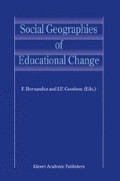Abstract
By using the notion of ‘geographies’ as a metaphor to represent the variability and mobility of people’s positions involved in processes of social change, in this chapter I will explore how visual cultural narratives are contributing to drawing and establishing adolescents’ identities. We particularly pay attention to these narratives related to visual popular culture because, as several authors (Giroux, Buckingham, Steimberg and Kincheloe) have noticed, they contribute to building a cultural pedagogy that is opposite, in many ways, to school pedagogy. Besides this consideration there is an emerging stream in the study of educational changes that claims to give more relevance and recognition to the subjects’ biographies and self-narratives. This relevance could be used as strategy to understand how school changes take place (or not) and to give more space to adolescents’ positions (making explicit their personal stories) into school innovations.
Access this chapter
Tax calculation will be finalised at checkout
Purchases are for personal use only
Preview
Unable to display preview. Download preview PDF.
References
Barker, B. (1999). The Dangerous and the Good? Developmentalism, Progress, and Public Schooling. American Educational Research Journal, 36,(4), 797–834.
Burr, V. (1995). An introduction to Social Constructionism. London: Routledge.
Butler, J. (1990). Gender trouble. Feminism and the Subversion of Identity. New York: Routledge.
Castells, M. (1998). La era de la información. Vol. 2. El poder de la indentidad. (The Information Age Volume II: The Power of Identity). Madrid: Alianza.
Champman, L. (2001). The mass arts in contemporary life (slide talk) Visual Culture Panel, NAEA Conference, New York, March 28 (quoted by Efland, 2002:154).
Duncum, P. (2001). Visual Culture: Developments, Definitions, and Directions for Art Education. Studies in Art Education, 42(2), 101–102.
Efland, A. (2002). Art and Cognition. Integrating the Visual Arts in the Curriculum. New York: Teachers College Press.
Efland, A. (2002). Art and Cognition. New York. Teachers College Press.
Erikson, E. (1968). Identity, Youth and Crisis. London: Faber.
Gergen, K. (1991). The Saturated Self. Dilemmas of Identity in Contemporary Live. New York: Basic Books.
Giddens, A. (1991). Modernity and self-identity. Self and Society in the Late Modern Age. Cambridge: Polity Press in association with Basil Blackwell.
Hall, S. (1996). Gramsci’s relevance for the study of race and ethnicity. In D. Morley & Kuan-Hsing Chen, (Eds.) Stuart Hall: Critical dialogues in cultural studies. New York: Routledge, 441–449.
Hernández, F. (2000). Recuperar el poder docente. An interview with Ivor Goodson. Cuadernos de Pedagogía, 295, 44–50.
Hernández, F. (2002a). Educación y desarrollo de la personalidad. (Education and development of the personality). In Los fines de la educación. Una reflexión desde la izquierda. (The Aims of Education. A reflection from the Left). Madrid: Biblioteca Nueva, 47–61.
Hernández, F. (2002b). Exploring Adolescents Identities through Visual Culture. In M. Samoraj (ed) Education through Art. Time Passing and Time Enduring. Warsaw: Agencja Reklamowo, 143–149.
Kincheloe, J. (1993). Toward a Critical Politics of Teacher Thinking: Mapping the Postmodern. Westport, CT: Bergin and Garvey.
Larraín, V. & Hernández, F. (2003). Visual Cultural Marks of Identity in Children’s Bedrooms as an Example of Emergent Changes in Childhood. Paper given to InSEA On Sea Conference, Helsinki, August.
Luke, C. (ed.) (1996). Feminism and Pedagogies of Everyday Life. Albany, NY: State University Press
Macklin, M.C. & Carlson, L. (Eds.). Advertising to Children. Concepts and controversies. London: Sage.
McNeal, J.U. (1998). Taping the Three Kids’ Markets. American Demographics, 20, 37–41.
Michael, M. (1996). Constructing Identities. The Social, the Nonhuman and Change. London: Sage.
Mitchell, C. & Reid-Walsh, J. (1995). And I Want to Thank You, Barbie: Barbie As Site of Cultural Interrogation. In H. Giroux & P. Shannon (Eds.) Education and Cultural Studies. London: Routledge, 103–118.
Miles, M. & Huberman A.M. (1985). Qualitative Data Analysis. London: Sage.
Mirzoeff, N. (1999). An introduction to Visual Culture. London: Routledge.
Moore, H. (1994). A passion for difference. Bloomington, IN: Indiana University Press.
Moxey, K. (1998). The History of Art after the Death of the “Death of the Subject”. Invisible Culture. An Electronic Journal for Visual Studies, 1,Winter. http://www.rochester.edu/in_visible_culture/ivchome.html
Peabody, R. & Ebersole, L. (1993). Mondo Barbie: An Anthology of Fiction and Poetry. New York: St. Martin.
Pauly, N. (2003). Interpreting Visual Culture as Cultural Narratives in Teacher Education. Studies of Art Education, 44(3), 264–284
Rakow, L.F. & Rakow, C.S. (1999). Educating Barbie. In S.R. Mazzarella and N.O. Pecora (Eds.) Growing Up Girls. Popular Culture and the Construction of Identity. New York: Peter Lang, 10–20.
Shotter, J. & Gergen, K. (Eds.) (1989). Texts of Identity. London: Sage.
Tavin, K. y Anderson, D. (2003). Teaching (Popular) Visual Culture: Deconstructing Disney in the Elementary Art Classroom. Art Education, 56,(3), 21–24.
Walker, J. A. & Chaplin, S. (1997). Visual Culture: an introduction. Manchester: Manchester University Press.
Walkerdine, V. (1999). Violent Boys and Precocious Girls: regulating childhood at the end of the millennium. Contemporary Issues in Early Childhood, Vol. 1, no. 1, pp. 3–22.
Editor information
Editors and Affiliations
Rights and permissions
Copyright information
© 2004 Kluwer Academic Publishers
About this chapter
Cite this chapter
Hernández, F. (2004). Mapping Visual Cultural Narratives to Explore Adolescents’ Identities. In: Hernandez, F., Goodson, I.F. (eds) Social Geographies of Educational Change. Springer, Dordrecht. https://doi.org/10.1007/1-4020-2495-9_7
Download citation
DOI: https://doi.org/10.1007/1-4020-2495-9_7
Publisher Name: Springer, Dordrecht
Print ISBN: 978-1-4020-2494-8
Online ISBN: 978-1-4020-2495-5
eBook Packages: Humanities, Social Sciences and LawEducation (R0)

